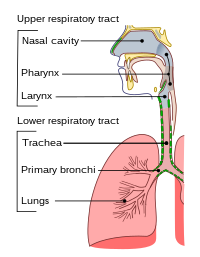
Photo from wikipedia
Long-segment tracheal airway defects may be congenital or result from burns, trauma, iatrogenic intubation damage, or tumor invasion. Although airway defects 6 cm continue to challenge surgeons worldwide. The reconstruction of… Click to show full abstract
Long-segment tracheal airway defects may be congenital or result from burns, trauma, iatrogenic intubation damage, or tumor invasion. Although airway defects <6 cm in length may be reconstructed using existing end-to-end reconstructive techniques, defects >6 cm continue to challenge surgeons worldwide. The reconstruction of long-segment tracheal defects has long been a reconstructive dilemma, and these defects are associated with significant morbidity and mortality. Many of these defects are not compatible with life or require a permanent extended-length tracheostomy that is fraught with complications including mucus plugging and tracheoesophageal fistula. Extensive circumferential tracheal defects require a reconstructive technique that provides a rigid structure able to withstand the inspiratory pressures, a structure that will biologically integrate, and contain functional ciliated epithelium to allow for normal mucociliary clearance. Tracheal transplantation has been considered the reconstructive "Holy Grail;" however, there has been a long-held scientific dogma that revascularization of the trachea was not possible. This dogma stifled research to achieve single-staged vascularized tracheal transplantation and prompted the introduction of many creative and inventive alternatives. Throughout history, alloplastic material, nonvascularized allografts, and homografts have been used to address this dilemma. However, these techniques have largely been unsuccessful. The recent introduction of a technique for single-staged vascularized tracheal transplantation may offer a solution to this dilemma and potentially a solution to management of the fatal tracheoesophageal fistula.
Journal Title: Transplantation
Year Published: 2023
Link to full text (if available)
Share on Social Media: Sign Up to like & get
recommendations!